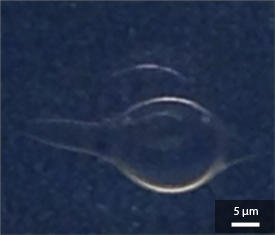

07/28/2014

Reproduced from Ref. 1 © 2013 M. Cui et al.
Droplets of water suspended in oil are spherical because this shape minimizes the contact area between these two immiscible liquids. Researchers from the AIMR at Tohoku University and the University of Massachusetts in the United States have now used nanoparticles to modify the shape of liquid drops suspended inside another liquid1. The drops retain their modified shapes for long periods of time. “This is the first demonstration of stable, long-lived, non-equilibrium shapes of one fluid inside another,” explains team leader Thomas Russell.
The researchers added the nanoparticles to a dispersion of water and an amine-ended polymer in oil. The polymers initially congregated at the interface between the oil and water. The nanoparticles then diffused from the aqueous phase to the interface, where they interacted with the amine groups of the polymer to form nanoparticle surfactants. These grouped together to minimize the surface tension at the interface.
Next, the researchers placed the system between two electrodes and applied an electric field. Electrostatic forces induced by the electric field caused the drops to deform and elongate into ellipsoids (see image). The surface area of each drop increased substantially while the drop volume remained constant, thus allowing more nanoparticle surfactants to form at the interface.
The extent to which the drops elongate depends on the strength of the applied electric field. When the researchers turned the electric field off, each drop tried to return to its original spherical shape. Although the drops did relax slightly, any significant decrease in surface area was prevented by the nanoparticle surfactants being grouped together at the interface. The team investigated a series of different groupings by changing the direction of the electric field, thereby creating a range of shapes. They also deformed the drops by stirring, thus forming tubules of water in the oil phase.
The drops retained their non-spherical shapes for at least a month. “Eventually the liquid within the droplet diffuses into the outer liquid and evaporates, causing the nanoparticle assembly to wrinkle,” explains Russell. In their wrinkled form, the droplets resemble raisins in appearance.
This work could help realize the dream of all-liquid batteries. “If one liquid is an insulating oil and the second is aqueous based, we can transport charge quickly within the aqueous phase from one side of a container to another,” says Russell. “This is precisely what is needed for battery applications; our work presents a route by which an all-liquid battery could be produced.”
Cui, M., Emrick, T. & Russell, T. P. Stabilizing liquid drops in nonequilibrium shapes by the interfacial jamming of nanoparticles. Science 342, 460–463 (2013). | article
This research highlight has been approved by the authors of the original article and all information and data contained within has been provided by said authors.